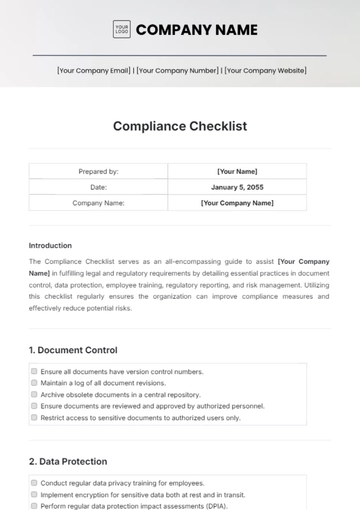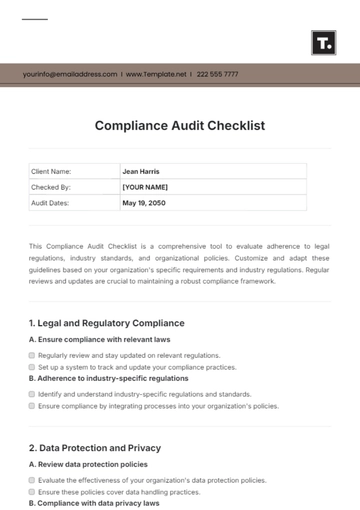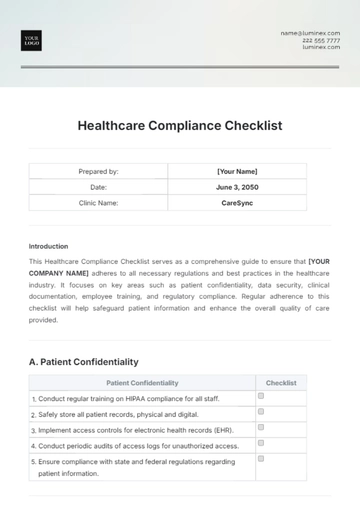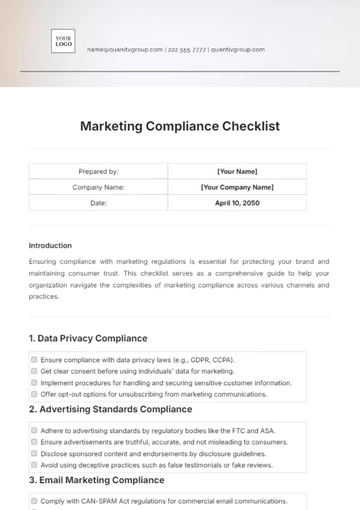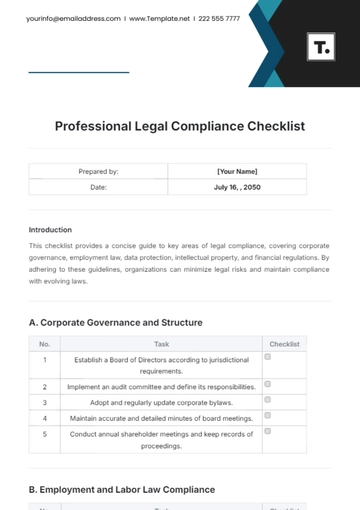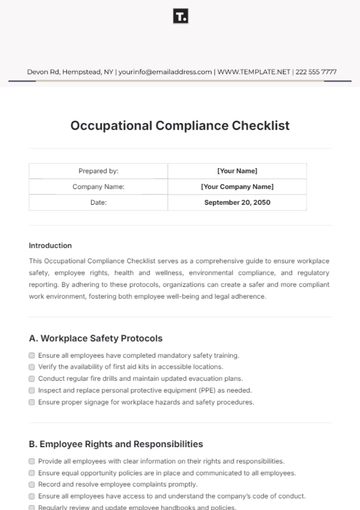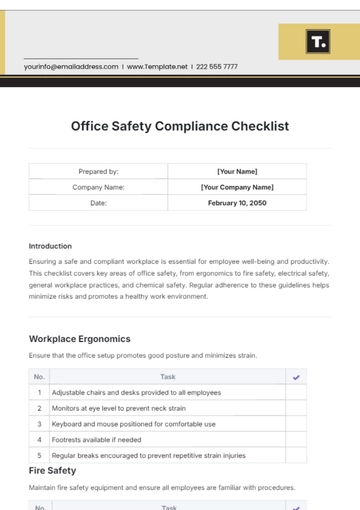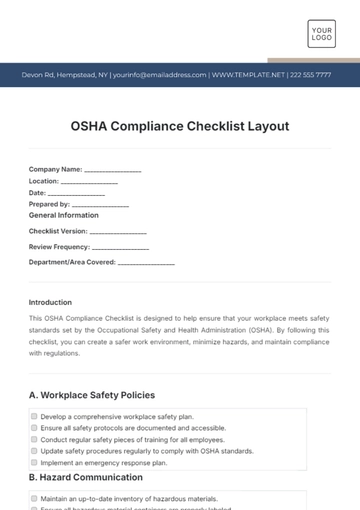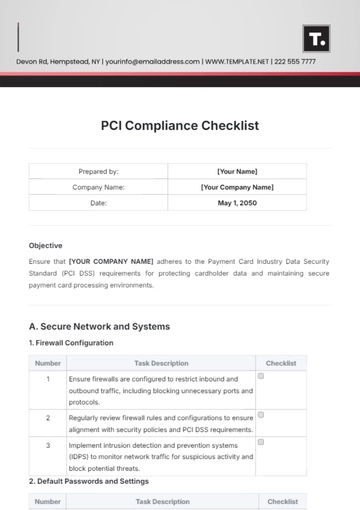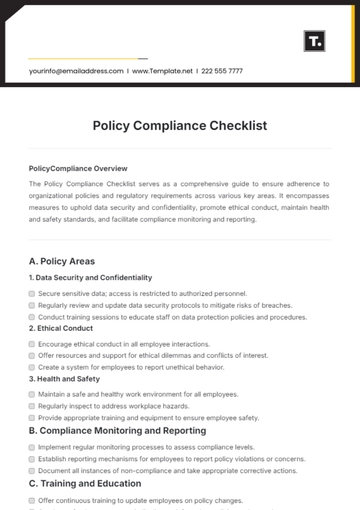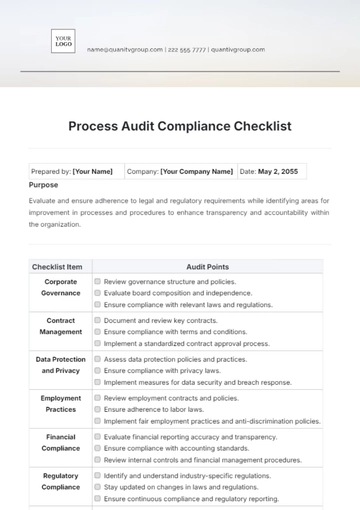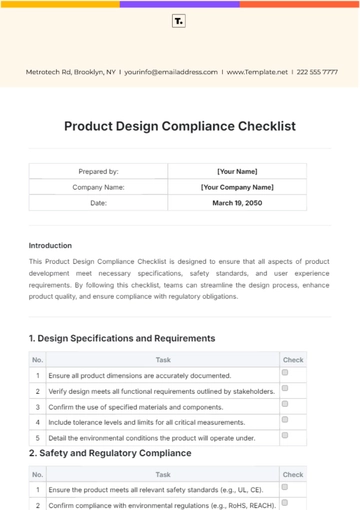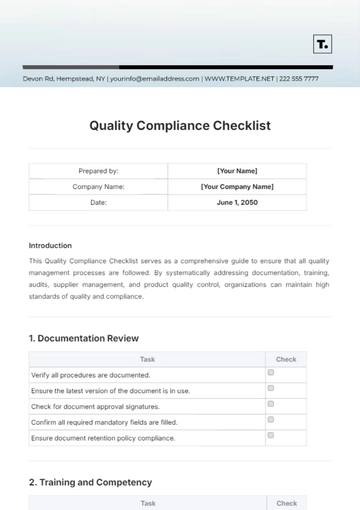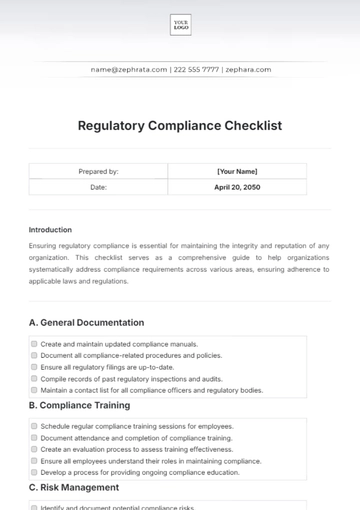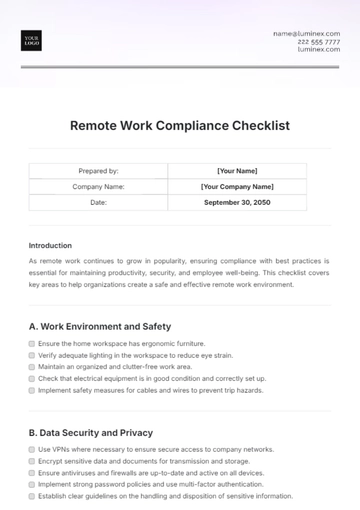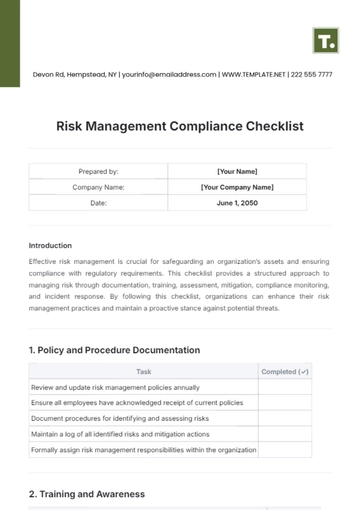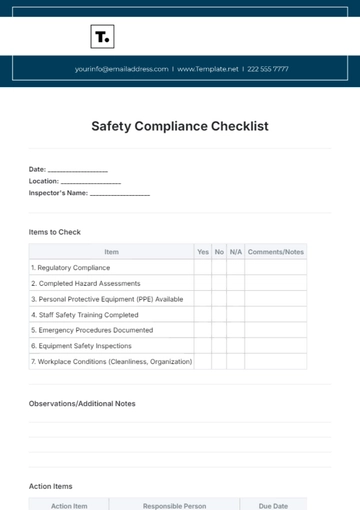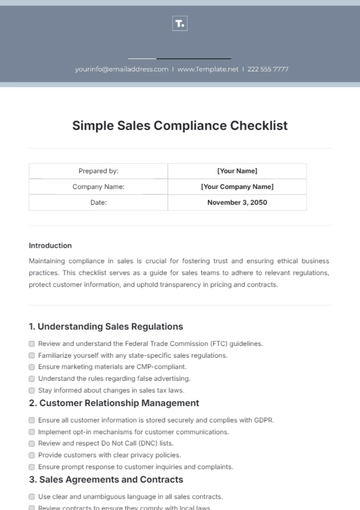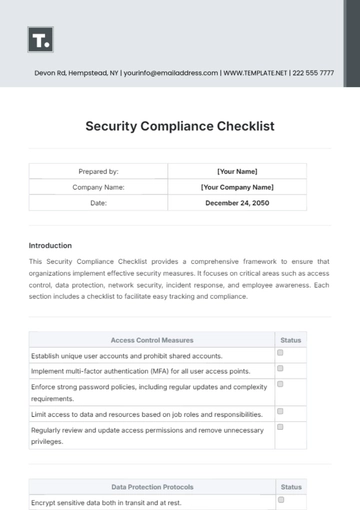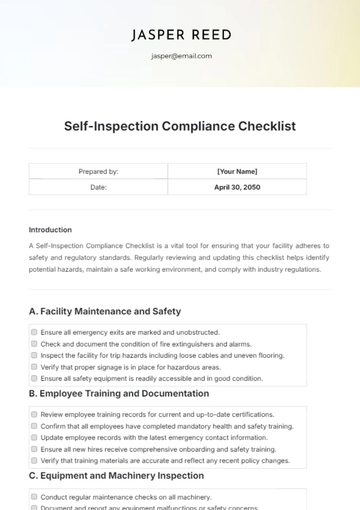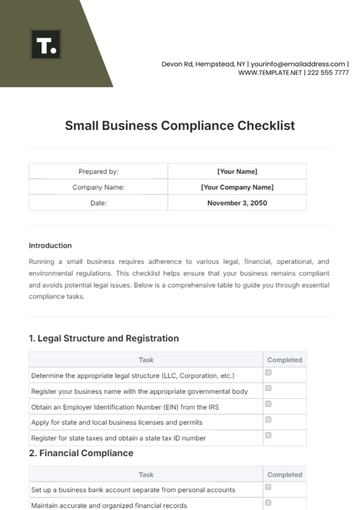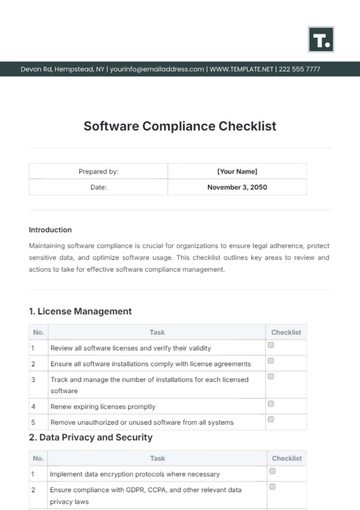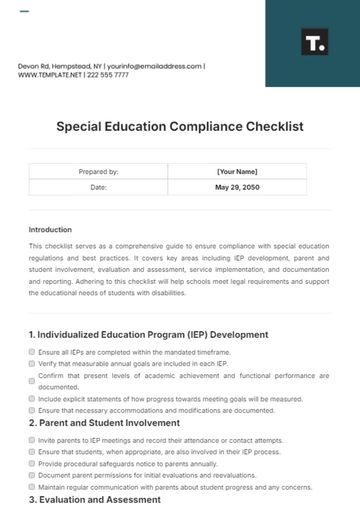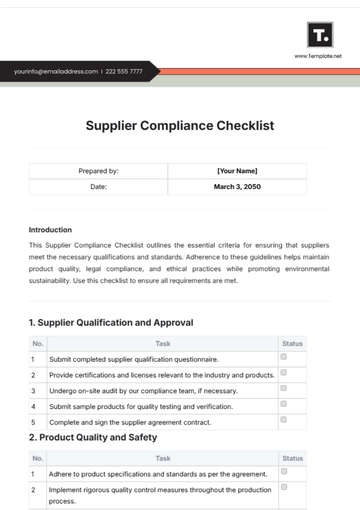Free Factory Compliance Checklist
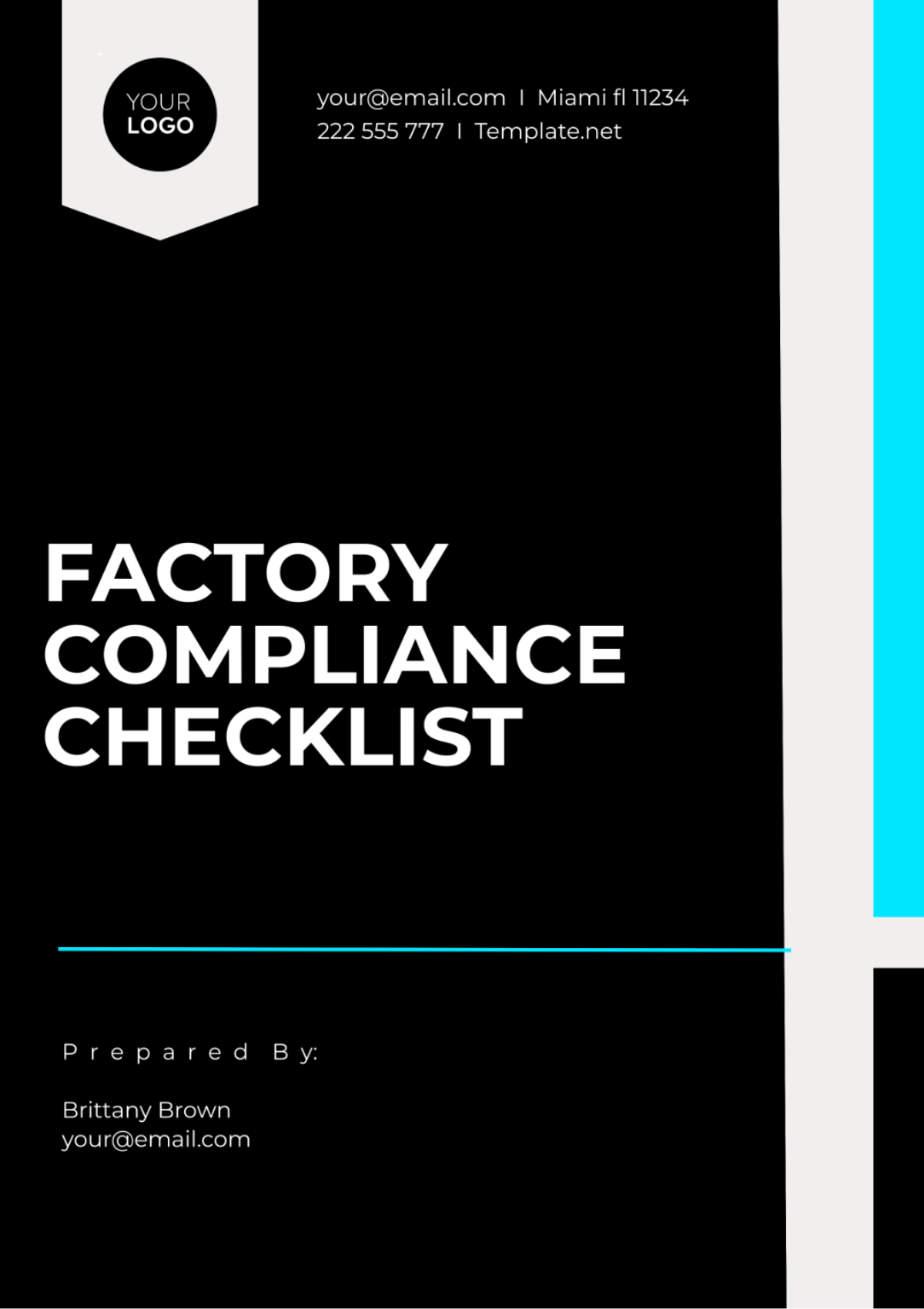
I. Compliance Overview
Objective: Ensure that [YOUR COMPANY NAME] adheres to regulatory requirements and industry standards to maintain a safe, ethical, and compliant manufacturing facility.
Responsible Party:[YOUR NAME], Compliance Manager
Date of Last Review: [DATE]
Next Scheduled Review: [NEXT REVIEW DATE]
II. Regulatory Compliance
Business Licenses and Permits:
Identify all required local, state, and federal business licenses and permits.
Obtain necessary licenses and permits for the factory's operation.
Keep licenses and permits up to date by renewing them as required.
Maintain documentation of all licenses and permits for regulatory compliance purposes.
Zoning and Land Use:
Review local zoning regulations and land use ordinances applicable to the factory location.
Ensure the factory's activities comply with zoning requirements.
Obtain any necessary zoning variances or permits for the factory's operation.
Consult with local zoning authorities to address any questions or concerns about compliance.
Environmental Permits:
Identify environmental permits required for the factory's operations.
Obtain permits for air emissions, wastewater discharges, hazardous waste management, and other environmental aspects as necessary.
Maintain permits and related documentation in compliance with regulatory requirements.
Stay informed about changes in environmental regulations that may affect permit requirements.
III. Occupational Health and Safety
Workplace Safety Policies:
Develop comprehensive workplace safety policies and procedures.
Include procedures for hazard identification, risk assessment, and control measures.
Ensure policies address specific hazards relevant to the factory environment.
Communicate safety policies to all employees and provide training on their implementation.
Review and update safety policies regularly to reflect changes in operations or regulations.
Safety Training:
Provide regular safety training to all employees, including new hires and existing staff.
Cover topics such as hazard recognition, emergency procedures, and proper use of personal protective equipment (PPE).
Tailor training programs to address specific hazards present in the factory environment.
Offer refresher training sessions periodically to reinforce safety knowledge and practices.
Document safety training sessions and employee participation for record-keeping and compliance purposes.
Machinery Safety:
Conduct regular inspections of machinery and equipment to ensure they are in good working condition.
Implement maintenance schedules to address any issues promptly.
Install guards and safety devices on machinery to prevent accidents and injuries.
Train employees on safe operating procedures for each piece of equipment.
Enforce compliance with safety regulations and manufacturer specifications for machinery use.
IV. Employee Welfare
Fair Labor Practices:
Ensure compliance with minimum wage requirements set by local, state, and federal laws.
Establish clear policies regarding working hours and overtime compensation.
Monitor employee work hours to prevent violations of labor laws related to overtime.
Adhere to child labor laws by employing minors only in permissible roles and ensuring compliance with work hour restrictions.
Employee Facilities:
Provide clean and accessible restrooms for employees.
Establish designated break areas for employees to rest and eat meals.
Ensure availability of clean drinking water for all employees throughout the workday.
Maintain facilities in good condition and address any issues promptly to ensure employee comfort and safety.
Anti-Discrimination Policies:
Develop and communicate anti-discrimination policies that prohibit discrimination and harassment based on protected characteristics.
Train managers and employees on anti-discrimination policies and procedures.
Establish reporting mechanisms for employees to raise concerns or complaints about discrimination or harassment.
Investigate any reports of discrimination or harassment promptly and take appropriate disciplinary action if violations are substantiated.
Foster a culture of inclusivity and respect in the workplace by promoting diversity and inclusion initiatives.
V. Environmental Management
Waste Management:
Develop procedures for segregating, storing, and disposing of waste materials in compliance with regulatory requirements.
Provide training to employees on proper waste handling and disposal practices.
Implement recycling and reuse programs to minimize waste generation and promote sustainable practices.
Monitor waste generation and disposal practices regularly to identify areas for improvement.
Energy Efficiency:
Conduct energy audits to identify opportunities for improving energy efficiency in manufacturing processes.
Implement energy-saving measures such as upgrading equipment, optimizing production schedules, and implementing energy management systems.
Educate employees on energy conservation practices and encourage their participation in energy-saving initiatives.
Track energy consumption and greenhouse gas emissions to measure the effectiveness of energy efficiency efforts.
Pollution Prevention:
Assess potential sources of pollution in factory operations and prioritize areas for pollution prevention efforts.
Implement measures to reduce air emissions, such as installing pollution control equipment and optimizing combustion processes.
Implement water conservation measures to minimize water usage and wastewater generation.
Substitute hazardous chemicals with safer alternatives where feasible and implement best practices for chemical handling and storage.
Monitor environmental performance indicators to track progress in pollution prevention efforts and identify opportunities for further improvement.
VI. Product Quality and Safety
Quality Control:
Define quality control procedures for each stage of the manufacturing process, from raw materials inspection to finished product testing.
Train employees on quality standards and procedures to ensure consistent adherence.
Implement quality control checkpoints and inspections to identify and address deviations from quality standards.
Document quality control activities and maintain records for traceability and accountability.
Continuously monitor and improve quality control processes based on feedback and performance data.
Product Safety Standards:
Research and understand safety standards and regulations relevant to your industry and products.
Conduct product testing and evaluation to ensure compliance with applicable safety standards.
Properly label products with safety information, warnings, and certification marks as required.
Regularly review and update product safety procedures to reflect changes in regulations or industry standards.
Monitor product safety incidents and recalls in the industry to stay informed and proactive.
Recall Procedures:
Establish clear procedures for initiating and managing product recalls, including communication channels and responsibilities.
Develop a recall plan that outlines steps for identifying affected products, notifying customers, and implementing corrective actions.
Train employees on recall procedures and their roles and responsibilities in the event of a recall.
Conduct regular drills or simulations to test the effectiveness of recall procedures and identify areas for improvement.
Maintain documentation of recall activities, including communication records, corrective actions taken, and lessons learned for future reference.
VII. Fire Safety and Emergency Preparedness
Fire Prevention:
Conduct regular inspections of fire extinguishers to ensure they are fully charged and in proper working condition.
Test smoke detectors and fire alarm systems regularly to ensure they are operational.
Ensure clear access to emergency exits and keep exit routes free from obstruction.
Train employees on fire prevention techniques, including proper storage of flammable materials and safe use of equipment.
Develop and implement a fire prevention plan that includes procedures for identifying and addressing fire hazards.
Emergency Response Plan:
Develop a comprehensive emergency response plan that outlines procedures for responding to various emergencies, including fires, natural disasters, and medical emergencies.
Communicate the emergency response plan to all employees and provide training on their roles and responsibilities during emergencies.
Establish evacuation routes and assembly points, and conduct regular drills to practice emergency procedures.
Designate employees to serve as emergency coordinators or first responders, and ensure they are trained to effectively manage emergency situations.
Review and update the emergency response plan regularly to incorporate lessons learned from drills and real-world incidents.
First Aid Facilities:
Maintain first aid kits stocked with essential supplies, such as bandages, antiseptics, and medications.
Ensure first aid kits are easily accessible and located in designated areas throughout the facility.
Train designated personnel in first aid techniques and CPR to provide immediate assistance in case of injuries or medical emergencies.
Post signs indicating the location of first aid kits and provide instructions for their use.
Regularly inspect and replenish first aid supplies to ensure they are up to date and readily available when needed.
VIII. Continuous Improvement
Compliance Audits:
Schedule regular audits and inspections to assess compliance with regulatory requirements, industry standards, and internal policies.
Review documentation, procedures, and practices related to safety, quality, environmental, and other relevant areas.
Identify areas of non-compliance, deficiencies, or areas for improvement during the audit process.
Document audit findings, including observations, recommendations, and corrective actions required.
Employee Feedback:
Establish channels for employees to provide feedback, such as suggestion boxes, anonymous surveys, or open-door policies.
Encourage employees to report safety concerns, compliance issues, or suggestions for improvement in factory operations.
Regularly communicate the importance of employee feedback and the organization's commitment to addressing concerns.
Actively listen to employee feedback, acknowledge their contributions, and respond promptly to address any issues raised.
IX. Signature
By signing below, you acknowledge that you have reviewed and understand the contents of this factory compliance checklist and affirm [YOUR COMPANY NAME]'s commitment to maintaining compliance with regulatory requirements and industry standards.

Compliance Manager
[YOUR COMPANY NAME]
Date:[DATE]
- 100% Customizable, free editor
- Access 1 Million+ Templates, photo’s & graphics
- Download or share as a template
- Click and replace photos, graphics, text, backgrounds
- Resize, crop, AI write & more
- Access advanced editor
Discover peace of mind with our Factory Compliance Checklist Template, available exclusively at Template.net. This meticulously crafted tool is fully editable and customizable, ensuring seamless integration with your specific needs. Effortlessly tailor your checklist using our Ai Editor Tool, simplifying compliance management like never before.
You may also like
- Cleaning Checklist
- Daily Checklist
- Travel Checklist
- Self Care Checklist
- Risk Assessment Checklist
- Onboarding Checklist
- Quality Checklist
- Compliance Checklist
- Audit Checklist
- Registry Checklist
- HR Checklist
- Restaurant Checklist
- Checklist Layout
- Creative Checklist
- Sales Checklist
- Construction Checklist
- Task Checklist
- Professional Checklist
- Hotel Checklist
- Employee Checklist
- Moving Checklist
- Marketing Checklist
- Accounting Checklist
- Camping Checklist
- Packing Checklist
- Real Estate Checklist
- Cleaning Checklist Service
- New Employee Checklist
- Food Checklist
- Home Inspection Checklist
- Advertising Checklist
- Event Checklist
- SEO Checklist
- Assessment Checklist
- Inspection Checklist
- Baby Registry Checklist
- Induction Checklist
- Employee Training Checklist
- Medical Checklist
- Safety Checklist
- Site Checklist
- Job Checklist
- Service Checklist
- Nanny Checklist
- Building Checklist
- Work Checklist
- Office Checklist
- Training Checklist
- Website Checklist
- IT and Software Checklist
- Performance Checklist
- Project Checklist
- Startup Checklist
- Education Checklist
- Home Checklist
- School Checklist
- Maintenance Checklist
- Planning Checklist
- Manager Checklist
- Wedding Checklist
- Vehicle Checklist
- Travel Agency Checklist
- Vehicle Inspection Checklist
- Interior Design Checklist
- Backpacking Checklist
- Business Checklist
- Legal Checklist
- Nursing Home Checklist
- Weekly Checklist
- Recruitment Checklist
- Salon Checklist
- Baby Checklist
- Equipment Checklist
- Trade Show Checklist
- Party Checklist
- Hospital Bag Checklist
- Evaluation Checklist
- Agency Checklist
- First Apartment Checklist
- Hiring Checklist
- Opening Checklist
- Small Business Checklist
- Rental Checklist
- College Dorm Checklist
- New Puppy Checklist
- University Checklist
- Building Maintenance Checklist
- Work From Home Checklist
- Student Checklist
- Application Checklist
